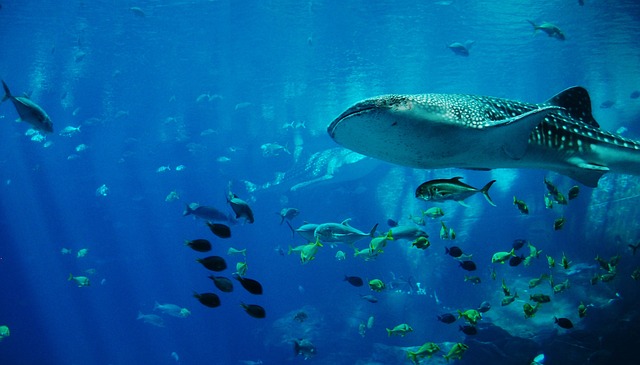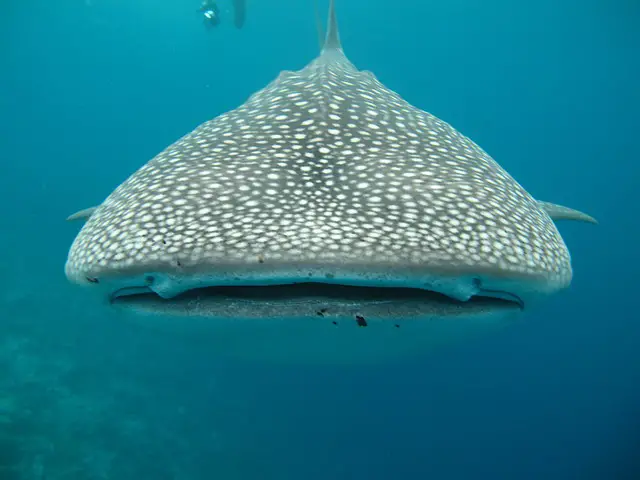Here are the most wonderful whale shark facts for kids including whale sharks diet, habitat, reproduction, and behavior. The whale shark (Rhincodon typus) is a slow-moving shark and is regarded as the largest extant fish species. They are also referred to as filter feeding sharks.
They can grow to a size of about 12.65 m (41.50 feet), with a weight measuring at 21.5 tonnes (47,000 lb), there are unverified reports of significantly larger whale sharks. There have been claims regarding the length measuring at 14 m (46 feet), with the weight of around 30 tonnes (66,000 lb).
These sharks have the honor of being called a mammoth size and are by far the largest non-mammalian vertebrate, rivaling many of the largest dinosaurs by weight. It is the only member of genus and the Rhincodontidae and it belongs to the subclass Elasmobranchii and the class Chondrichthyes. These species are believed to have been evolved some 60 million years ago.
The whale sharks are known to reside in the warm oceans and tropical waters in the wide sea with a lifespan of about 70 years. In spite of their larger mouth, they mainly feed on microscopic plants and animals including plankton. They were identified at the start of 19th century in 1828 when the specimen of about 4.6 m (15.1 feet) was found to harpoon in Table Bay, South Africa.
 Whale Shark Facts For Kids
Whale Shark Facts For Kids
- The mouth size of the whale shark measures around 1.5 m (4.9 feet) by width and contains 10 filter pads and flanked by 300 – 350 rows of small teeth.
- It has five bulky grill pairs.
- Two small eyes are positioned toward the wide whale shark’s head.
- It has almost a grey body with a white belly; three major ridges run along each side of the shark and skin is stained with a checkerboard of yellow markings and stripes.
- These markings are alone to each species and are effective for counting populations.
- The thickness of a skin measures around 10 cm (3.9 inches).
- It has a pair each of dorsal fins and pectoral fins.
- The young sharks have a tail greater than lower fin while the adult tail turns out to be semi-lunate. Spiracles are located at the back of whale shark.
- This is the largest non-cetacean animal in the world.
- The average size of an adult whale shark measures around 9.7 m (31.82 feet), with a weight measuring at 9 tonnes (20,000 lb).
- The largest confirmed specimen was caught in 1947, November 11, at Karachi (Pakistan), near Baba Island. The length of that specie was measured at 12.65 m (23.0 feet). There are, however, rumors regarding larger sharks than this such as 18 m (59 feet), and 45.5 tonnes (100,000 lb).

Distribution
Whale shark has a cosmopolitan distribution and they are primarily found in tropical and subtropical waters.
Although occasionally, whale sharks are also found in the Great Rann of Kutch, Ningaloo Reef, Utila, Pasacao, Honduras, Yucatan, Isla Mujeres, Btangas, and Donsol. The countries include India, Philippine, Brazil, Mexico, Western Australia, Indonesia, South Africa, Tanzania, Islands of Pemba, Zanzibar, and Mafia.
One of the largest concentrations of whale sharks were found in the Yucatan coast of Mexico, comprising more than 400 species gathered in a single place to feed on spawn from little tunny.
Habitat
Whale sharks are pelagic species as they often approach coastal areas. They also migrate each spring to the continental shelf which is at the central coast of Australia. Because of the coral spawning of the region’s Ningaloo Reef, there is abundant of plankton supply.
These fish are capable to dive deep into the depths of around 1,286 m (4,219 feet). The largest specimen measured at 11 – 12 m(36 – 39 feet), together with a weight measuring at 7,000 kg (15,000 lb).
Feeding Ecology and Diet
These sharks are the filter feeders together with the basking sharks and megamouth sharks. They primarily feed on plankton, krill, Christmas Island red crab larvae, algae, and tiny nektonic life including vertebrates and squid. Whale sharks also feed on small fish and clouds of eggs.
The filter pads facilitates in separating the food from water. Food separation in these sharks is facilitated by cross-flow filtration in which the water flows along with filter pad surface, before being extracted outside. They are considered to be energetic feeders, believed to focus on a large quantity of fish and plankton.
Although they are greater in size, whale sharks do not pose any real danger to humans. Even with their massive size, whale sharks are docile fish and for a while allow swimmers to catch a ride, although this exercise is discouraged by shark biologists and scientists.
Actually these sharks are fairly gentle and can play with divers. Divers are believed to have seen whale sharks in numerous places such as Christmas Island, Ningaloo Reef (Western Australia, Taiwan, Isla Coiba (Panama), Galapagos Islands, Bahia de Los Angeles (Mexico), the Bay Islands in Honduras (Thailand), Philippine, the Red Sea (Maldives), Belize, Tofo Beach (Mozambique), Sodwana Bay (Greater St. Lucia Wetland Park), the Seychelles (West Malaysia), eastern peninsular Malaysian Islands, Sri Lanka, Fujairah, and Puerto Rico.
Reproduction
These fish are ovoviviparous. The length of the sharks measure around 46 – 60 cm (16 – 24 inches). They reach maturity at the age of 30 years with the lifespan of about 70 – 100 years.
Conservation
In some countries whale sharks are protected because there are very few actual threats to these large fishes. Taiwan and India are the only countries to have fisheries of whale shark however the effects (of fisheries) on its population in Pacific Ocean is unknown.
Atlantic Ocean do not offer any whale shark fishery. The shark is listed as Vulnerable by the IUCN.
Learn more


Leave a Reply